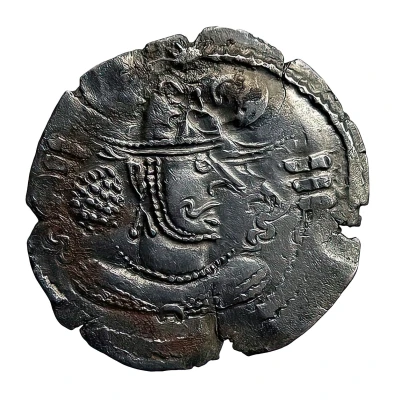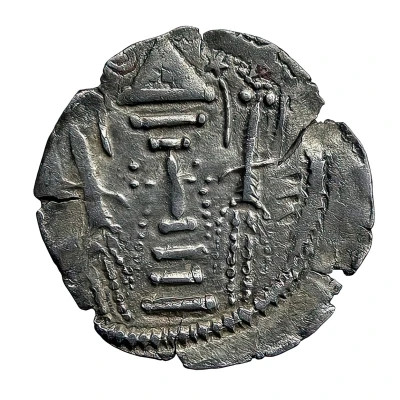


© Virasat Auctions
Drachm Gurjura Early Imitations ND
| Silver | 3.92 g | 25.42 mm |
| Issuer | Gadhaiya (Indian Northern Dynasties) |
|---|---|
| Type | Standard circulation coin |
| Years | 500-700 |
| Value | 1 Drachm |
| Currency | Drachm (543-1390) |
| Composition | Silver |
| Weight | 3.92 g |
| Diameter | 25.42 mm |
| Thickness | 1.32 mm |
| Shape | Round (irregular) |
| Technique | Hammered |
| Demonetized | Yes |
| Updated | 2024-10-05 |
| Numista | N#374944 |
|---|---|
| Rarity index | 94% |
Reverse
A crude depiction of the Sassanian fire altar flanked by attendents, A dotted border around,
Edge
Plain
Comment
Steve Williams (Finn235) :At the beginning of the Gadhaiya Paisa track is a series of enigmatic coins. Significantly more diverse than any other series, these remain something of a mystery. Leading theories hold that these were either brought into India from Hepthalite and other Hunnic tribes in the 6th-8th centuries, or that they are a native invention inspired by the coinage of the invaders. (Cited from: https://www.cointalk.com/threads/indo-sassanian-coinage-series-1-1-early-types.341648/#google_vignette)
Maheshwari (KK Maheshwari - Imitations In Continuity) attributes these coins to the Gurjjar people, a warrior clan who originated in Central Asia. They supposedly migrated with the Hephtalites and/or Alchons during their invasion of India in the 500s as something between slaves and mercenaries-for-hire (Cited from: https://www.cointalk.com/threads/indo-sassanian-coinage-series-1-1-early-types.341648/#google_vignette)
All are copies of Peroz I's third crown type drachm, featuring a winged helmet and royal ribbons flanking the portrait on either side. The reverse features a fire altar flanked by two attendants, star/sun and moon above. (Cited from: https://www.cointalk.com/threads/indo-sassanian-coinage-series-1-1-early-types.341648/#google_vignette)
few other variants -
Interesting fact
One interesting fact about this coin is that it was used as a form of currency in the Indian Northern Dynasties during the 5th to 7th centuries, and it was made of silver, which was a valuable and durable material at the time.